 |  |  |  |  | CloudSat and CALIPSO: Revealing the Secrets of Clouds and Aerosols
|
09.14.05
|
The sky stretches above us like an endless canvas, but of its most familiar components, the clouds, we actually know very little.
That’s why NASA is sending two new satellites into space. Looking down from orbit, scientists can gather information about clouds, ice crystals, aerosols, and a range of related subjects. CloudSat will help precisely measure key elements of the water cycle, CALIPSO will pursue knowledge about short-term air quality and both missions address long-term climate issues. They’re designed to do this as a matched pair, taking nearly simultaneous measurements of the same spot over Earth. Together, these satellites will help answer important questions about the nature of our planet.
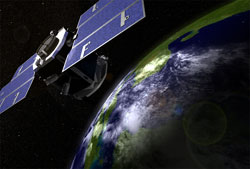 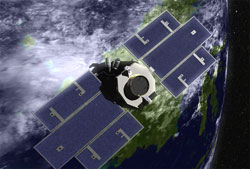
Images/animation above: CloudSat satellite animation: CloudSat is an Earth observing system designed to look down through clouds from the vantage point of space. CloudSat will provide scientists a never-before-seen perspective on Earth’s clouds, allowing them to peer into them and study the processes that convert cloud droplets into rain and snow. Click on left image to view animation. Click on right image to enlarge. Credit: NASA
Print resolution stills available below:
+ Cloudsat 1 | + Cloudsat 2 | + Cloudsat 3
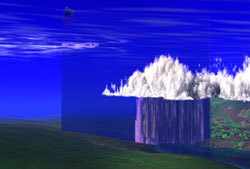 
Images/animation above: CloudSat science animation: CloudSat flies a first-of-its-kind radar system that is much more sensitive than any current weather radar. CloudSat will provide new information about the vertical structure of clouds, including the quantities of liquid water and ice they contain, and how clouds affect the distribution of the sun’s energy in the atmosphere. These measurements will help with research into atmospheric circulation models and weather patterns. The data will also help scientists develop better tools for making weather and climate predictions in the future, and provide insights into the global water cycle. Click on left image to view animation. Credit: NASA
Print resolution stills available below:
+ CloudSat science 1 | + CloudSat science 2
 
Images/animation above: CALIPSO satellite animation: The main instrument on CALIPSO takes measurements of natural processes via laser light. The technology is called lidar, and on CALIPSO its purpose is to determine the distribution of aerosols and thin clouds around the world. Coupled with its sibling satellite CloudSat, CALIPSO will help scientists develop never-before-seen views of Earth’s atmospheric structure and behavior. Click on left image to view animation. Click on right image to enlarge. Credit: NASA
Print resolution stills available below:
+ CALIPSO 1 | CALIPSO 2 | + CALIPSO 3
 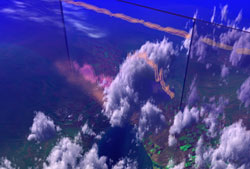
Images/animation above: CALIPSO science animation: Scientists are eager to use CALIPSO data to study the nature of the atmosphere. Using lidar and a pair of infrared and visible imaging systems, CALIPSO promises to deliver new insights into how clouds and aerosols work to affect the atmosphere. Click on left image to view animation. Credit: NASA
Print resolution stills available below:
+ CALIPSO
science 1 | + CALIPSO
science 2
 
Images/animation above: Weather: The study of meteorology presents significant challenges to scientists. One of the most challenging aspects is the inherent complexity of weather coupled with its high rate of change. In the case of clouds, scientists seek new insights into how they form, behave, and interact with the Earth’s atmosphere. Engineers designed Cloudsat and Calipso to deliver the data needed by scientists to provide new understanding of how clouds, water vapor, ice particles, and aerosols affect the weather. Click on left image to view animation. Credit: NASA
Print resolution stills available below:
+ Weather
1 | + Weather
2 | + Weather
3
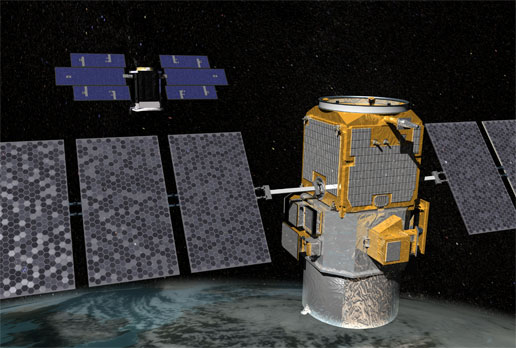
Image/animation above: A-Train - CloudSat and CALIPSO Pairing: CloudSat and CALIPSO will be launched into a 705-kilometer (438-mile) circular, Sun-synchronous polar orbit, where they will fly just 15 seconds apart, at more than fifteen thousand miles per hour. This pairing sets a new standard in terms of precision placement of Earth-orbiting satellites. The reason for this is simple: both satellites will look at the same clouds in the atmosphere. Considering how quickly clouds change and transform in the sky, the instruments passing overhead need to be close in order to take the measurements at nearly the same time. Click on image to view animation. Credit: NASA
Print resolution still available below:
+ CloudSat CALIPSO pairing
 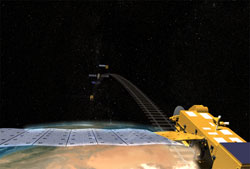
Images/animation above: A-train—The big picture: The Afternoon Train or 'A-Train' is the nickname given to a group of satellites that fly close together and pass over the equator in the early afternoon. The A-Train provides coordinated science observations of Earth and its atmosphere. Besides CloudSat and CALIPSO, other members of the A-Train include the NASA Missions Aqua and Aura, a Centre National d'Etudes Spatiales (CNES) mission called PARASOL (Polarization and Anisotropy of Reflectances for Atmospheric Sciences coupled with Observations with a Lidar), and may eventually include NASA's OCO (Orbiting Carbon Observatory). Each satellite has a unique set of Earth observing capabilities, but this is a case where the whole is greater than the sum of the parts. Together, these diverse tools give us the most comprehensive set of observations of Earth's atmosphere ever obtained. Click on left image to view animation. Credit: NASA
Print resolution stills available below:
+ A-train 1 | + A-train 2
For video resources on CloudSat and CALIPSO please contact Sarah DeWitt, NASA Goddard Space Flight Center, at 301-286-0535.
Michael Starobin
Goddard Space Flight Center
|
|  |
